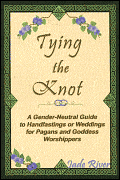
Pagans who want to “tie the knot” (which, we learn on p. 53, is a magical practice in many cultures) or legalize their living arrangements won’t find a more practical guide than this book by Jade River, founder of the Re-formed Congregation of the Goddess. The book’s thirteen chapters tell us how to do everything from planning ahead to taking it apart in case of death of a spouse (bury the handfasting cord with the deceased partner) or divorce (burn the cord or toss it into flowing water).
Everyone who has ever attended an impromptu, barefoot pagan beach wedding has funny stories to tell. Most of these stories are about what can happen when the handfasters and their priest or priestess did not plan adequately. “The best reasons to put some time and energy into planning,” Jade writes, “are to ensure that your ceremony is everything that you want it to be and to reduce or eliminate stress from this most important day of your lives. … [T]he magic of your handfasting ceremony is enhanced if you’re not worrying about the many details involved” (pp. 1-2). Yes, this seems obvious. Many handfasters are so starry-eyed, however, that the mundane details never even occur to them. That’s why you need this book.
The first thing to consider is your vows. What are you promising each other? Love, honor, and obedience? As long as you both shall live? As long as you both shall love? For a year and a day? Into your next life? The book explains the ramifications of each of these options. Also important in this book is its attention to same-sex couples being handfasted and what variations on traditional customs they can consider.
Chapter 3 discusses setting the date and time, with astrological implications as well as purely mundane concerns like dealing with holidays and work and school schedules. We learn that June is the most popular month for weddings, that Saturday is the most popular day, that 7 p.m. is the most popular time. Since many pagans have nonpagan parents or other relatives, chapter 5 tells you how to break the news. Jade cautions that if someone proclaims that being handfasted “is a sin against God,” that’s probably someone not to invite, though Grandmother may deal with the news better than Mom thinks she will. Other chapters tell us what we need to know about the ceremony itself—formal, semi-formal, and informal are defined—the priest/ess, attendants and witnesses, and optional activities. Clothing gets its own chapter, and we learn that it’s the bride’s gown that has traditionally dictated the level of formality of everything else. Jade also notes that customs vary nowadays and pagan weddings tend to be eclectic.
Seven appendices also provide useful information, from a script for the ceremony with several options to a timeline to information about finances and who traditionally pays for what. It’s good, Jade says, to start planning at least six months before the ceremony. It’ll be a busy six months. If you have this book, it’ll be a slightly less frenetic six months.
~review by Barbara Ardinger, Ph.D.
Author: Jade River
Creatrix Books, 2004
